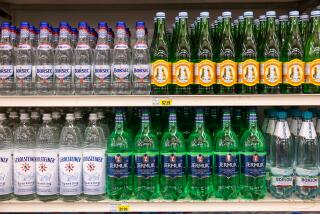Tasteless or brilliant? Iceberg water might be both
- Share via
Reporting from Washington — Sometime in the next two weeks, a converted fishing boat called the Sikuk is due to sail from St. John’s, in Canada’s Newfoundland province, bound for a fjord in Greenland and a rendezvous with an iceberg.
Where most vessels give icebergs a wide berth, the Sikuk intends to sidle up close and — using a giant mechanical claw — begin ripping 1,500-pound bites of ice from floating bergs and depositing them in tanks below deck.
The product of this bizarre harvest is destined to become something called Glace Rare Iceberg Water, and it represents the latest turn in the lifelong obsession of a native Newfoundlander named Ron Stamp. Where others saw hazards to navigation, Stamp has long seen icebergs as objects of wonder and — eventually — as the key to his fortune.
As a child growing up on the coast of Newfoundland, Stamp says, he was fascinated by the giant blocks of ice floating in the North Atlantic. Then, as a relatively young man, he began to see them as sources of potential profit. And for most of the last 20 years, he has worked to make that vision come true — with varying degrees of success.
Stamp tried iceberg vodka; it had only limited success. The same with iceberg beer.
So now he’s trying gourmet water — at $10 a bottle. Or more.
Why would anyone pay the price of a decent bottle of wine to guzzle melted iceberg? Stamp admits it’s a bit of a mystery, but he thinks it will work.
“It is so tasteless that it actually creates a taste. The tastelessness is its own taste,” he said. “It’s like drinking air.”
So-called gourmet bottled waters make up less than 5% of the $10.6-billion U.S. bottled water market. It’s a crowded space, filled with names like Etrusca, Lelu, Vytautas, Vidago, Karoo and Tasmanian Rain.
There also are at least three other similarly priced, though less ambitiously marketed, iceberg waters, as well as entrants like Bling H20, which offers east Tennessee spring water in a Swarovski crystal-encrusted bottle for $50.
“Water is not water anymore. Water is the new wine,” said Michael Mascha, a onetime food anthropologist, who runs the finewaters.com website and holds tastings to evangelize for greater epicurean regard for water.
Water from different places on the globe has unique tastes, Mascha said, because of differences in mineral content, bubble size, pH levels and hardness or softness. Iceberg water is unique in that it comes from snow that fell perhaps 12,000 years ago — millennia before the Industrial Age filled the atmosphere with impurities.
Mascha characterized iceberg water as “very neutral, very soft … perfect for very subtle foods like sushi and sashimi.”
“It is one of the next great things that we will have as a high-end product, with a tremendous story to tell,” he predicted.
Mascha keeps a stash of Iluliaq brand iceberg water from Greenland in his refrigerator.
“It’s for a nice meal … if you want to impress someone. It’s an aspirational product, like a nice bottle of wine, a nice bottle of Champagne,” he said.
Stamp, 56, who lives in St. John’s, said he became serious about making money from icebergs in the early 1990s, about the time the collapse of the cod fishery put an end to his career as a seafood broker.
Icebergs, he realized, were an almost limitless resource.
And, he said, “from a marketing and sales perspective, it attracts a horrifying amount of attention. If I sold Ron’s Spring Water, nobody would ask me a second question.”
A decade ago, Stamp tried selling an iceberg water named Borealis in plastic bottles. But the packaging defined Borealis as a mass-market item, and Stamp couldn’t sell it at a competitive price. “I’d have to own 10 ships” to harvest enough ice, he said.
Starting last year, he began decanting his water into glass bottles and gave it the French name for “ice.”
“It has a certain appeal,” Stamp said. “‘Iceberg’ is too masculine a sound. This is water your wife’s going to bug you to get because it matches the dishes.”
To enter the U.S. market, Glace needed — and late last month won — approval from the Food and Drug Administration. But even in that, it was a special case: Though FDA labeling rules spoke to artesian water, groundwater, mineral water, sparkling bottled water, spring water and well water, as well as purified water produced by distillation, deionization or reverse osmosis, they didn’t address iceberg water.
Stamp declined to disclose Glace sales figures, but he said he and his partners spent $4.5 million to modify the Sikuk to collect ice instead of herring and mackerel.
Stamp hopes the Sikuk eventually will make 10 harvesting trips a year. But for now, plans call for the ship and its eight-man crew to make the 21-day round trip to Greenland or, in warmer weather, shorter forays into Iceberg Alley off the coast of Newfoundland, as demand requires.
After the ice is crushed and melted, the Sikuk ferries 550,000 liters of water to St. John’s for shipment to a bottling plant in Montreal via container vessel.
Not everyone is taken with the concept of iceberg water.
“This sounds like an incredibly bad idea just in terms of resource use. We have tap water. We have rain. Why do we have to send a ship out to Greenland? Maybe the water will be 10% cleaner. But what about all the carbon dioxide created?” said Renee Sharp, director of the California office of the Environmental Working Group.
Stamp says he’s sensitive to Glace’s carbon footprint. Its bottles are recyclable and the Sikuk’s retrofit included governors on its engines to cut horsepower and a switch to more efficient fuel.
Besides, Stamp said, “of all the products that are shipped, water is the lifeblood of the planet. Why pick on water? What about sneakers, or toys, or fertilizer?”


